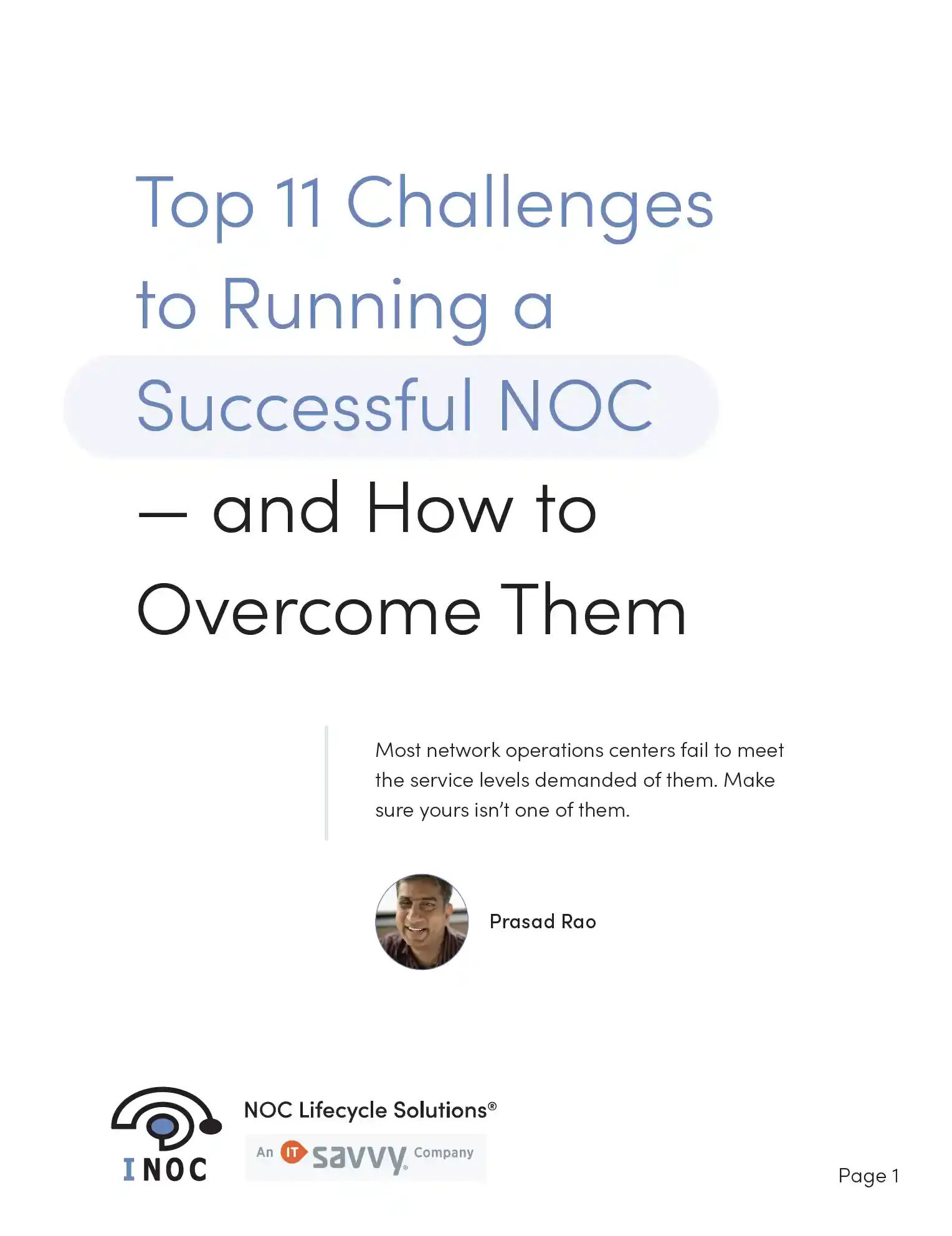As IT infrastructures grow more complex and—business dependencies on digital services deepen, the effectiveness of incident management within Network Operations Centers (NOCs) has become a critical factor in organizational success.
In 2025, incident management is no longer just about restoring service quickly. It's about providing a seamless operational response that minimizes business impact while continuously improving service reliability.
Having worked with enterprises, service providers, and OEMs to build and optimize NOC operations for years, I've seen firsthand how the right incident management approach transforms reactive support mechanisms into strategic business assets. In this guide, I'll walk through what effective incident management looks like in 2025 and how organizations can implement processes that deliver exceptional results.
The model presented here is a deconstruction of our own incident management process used to support hundreds of companies.
Read our comprehensive guide to NOC management: The Definitive Guide to Enterprise Network Management
The Incident Management Landscape in 2025
Before we get into the weeds, let’s step back and get some important context. Today's IT environments typically generate thousands of events daily across hybrid infrastructures spanning traditional data centers, cloud instances, edge deployments, and software-defined networks.
These complex ecosystems demand sophisticated incident management capabilities that go well beyond basic monitoring and ticketing—yet basic monitoring and ticketing is still what we see in place in the vast majority of support teams. Networks have outgrown the NOCs looking after them.
The modern incident management lifecycle comprises several interconnected processes that form a continuous improvement loop:
-
- Event monitoring and management
- Incident logging and categorization
- Incident prioritization and notification
- Impact assessment and initial triage
- Investigation and diagnosis
- Resolution and recovery
- Incident closure and documentation
- Post-incident analysis and improvement
While this framework may appear straightforward, implementing it effectively requires a structured operational approach and cutting-edge technological capabilities.
Let's examine each component in detail.
Event Monitoring and Management
Every incident begins with detection.
Modern event monitoring extends far beyond simple up/down monitoring to encompass sophisticated performance analysis, anomaly detection, and proactive issue identification.
Effective event monitoring in 2025 now includes:
- Multi-source data collection: Consolidating events from network devices, servers, applications, cloud services, and security tools into a unified monitoring framework.
- Intelligent filtering: Distinguishing actionable events from informational alerts to prevent alert fatigue.
- Correlation and contextualization: Connecting related events to identify their collective meaning and impact.
- Business service mapping: Understanding which technical components support specific business services to prioritize events appropriately.
In our operations at INOC, we've found that organizations monitoring hundreds of devices can generate hundreds and even over a thousand events during peak hours daily. Without effective filtering and correlation mechanisms, these volumes quickly overwhelm even well-staffed NOC teams.
The key to mastering event management is implementing an intelligent event correlation engine that can automatically determine when multiple alerts represent a single underlying issue. This critical capability reduces "noise" and allows engineers to focus on meaningful incidents rather than symptoms.
Incident Logging and Categorization
When an event or set of correlated events indicates an actual or potential service disruption, the incident management process formally begins. Proper logging and categorization are foundational to effective response.
The incident record must capture essential information:
- Services and configuration items affected
- Time of occurrence
- Detection mechanism (automated alert, user report, etc.)
- Initial symptom description
- Categorization (type of incident)
- Initial severity assessment
What differentiates leading incident management operations in 2025 is how this process is executed.
Rather than requiring NOC engineers to manually create tickets from alerts or calls, modern platforms automatically generate incident records with rich contextual information.
Our Ops 3.0 Platform showcases this approach by integrating alarm management with an advanced CMDB (Configuration Management Database). When an incident is created, the system automatically associates affected configuration items, retrieves relevant historical data, and attaches knowledge articles specific to the incident type. This enrichment provides NOC engineers with a comprehensive view of the incident from the moment they begin working it.
Below is a high-level schematic of our Ops 3.0 platform. Read our in-depth explainer for more on it.

The workflow generally moves from the left to the right of the diagram as monitoring tools output alarm and event information from a client NMS or ours into our platform, where a number of tools process and correlate that data, generate incidents and tickets enriched with critical information from our CMDB, and triage and work them through a combination of machine learning and human engineering resources. ITSM platforms are integrated to bring activities back into the client's support environment and the system is integrated with client communications.
Incident Prioritization and Notification
Not all incidents are created equal! Effective prioritization ensures that resources are allocated appropriately based on business impact and urgency. In 2025, sophisticated prioritization frameworks consider multiple factors:
- Service criticality: The business importance of affected services.
- Impact scope: The number of users or systems affected.
- Redundancy status: Whether high-availability mechanisms are functioning.
- Time sensitivity: Business cycles or peak usage periods.
- Compliance implications: Regulatory or contractual obligations.
At INOC, we use a four-tier prioritization system:
| Priority 1 (Critical): Complete service outage with no redundancy; the client is hard down and operations are at a standstill until resolution. |
Priority 2 (High): Severe service impairment or redundant component failure; the client remains operational but with significant limitations (e.g., a redundant link is down or primary path experiencing severe latency). |
Priority 3 (Medium): Partial service impairment; the client is experiencing noticeable issues that impact service quality, but operations continue (e.g., intermittent connectivity or performance degradation). |
Priority 4 (Low): Informational or scheduled maintenance; no immediate service impact but attention required for future stability. |
This prioritization directly drives notification workflows, determining who needs to be informed, through which channels, and with what urgency. Modern incident management systems automate these notifications based on the incident classification, ensuring appropriate stakeholders are engaged without delay.
Impact Assessment and Initial Triage
Once an incident is logged and prioritized, the next critical step is rapid impact assessment. This process determines the full scope of the issue and establishes an initial action plan.
In traditional NOC environments, this assessment process often consumes substantial time as engineers manually investigate affected systems, cross-reference documentation, and attempt to determine what's happening. By 2025, leading NOC operations have radically transformed this approach through intelligent automation and advanced operational frameworks.
The structured NOC approach we've implemented at INOC places an Advanced Incident Management (AIM) team at the beginning of our workflow. This specialized team, comprised of senior troubleshooting personnel, conducts an initial analysis to:
- Determine the exact nature of the problem.
- Assess the full scope of impact.
- Create a clear action plan for resolution.
- Appropriately route the incident to the correct resolution team.
We’ve found that this model delivers significant advantages over traditional approaches. By positioning skilled analysts at the front of the workflow, we make sure incidents are correctly diagnosed and routed from the start—eliminating the common pattern of misdiagnosis and multiple escalations that plague many NOC operations.
Our platform supports this workflow through Time to Impact Assessment (TTIA) metrics—a key performance indicator that measures how quickly we can provide clients with a clear understanding of what's happening, which services are affected, and what's being done to resolve the issue. By tracking and optimizing TTIA, we consistently reduce the uncertainty window that causes anxiety for stakeholders during outages.
Investigation and Diagnosis
With impact assessed and initial triage complete, NOC engineers must identify the underlying cause of the incident. This investigative process has traditionally relied heavily on individual expertise and familiar troubleshooting patterns—an approach that creates inconsistency and depends on tribal knowledge.
In 2025, mature NOC operations implement structured diagnosis workflows supported by machine learning assistance and comprehensive knowledge management. Key components include:
- Runbook automation: Pre-defined, executable troubleshooting procedures that ensure consistent response regardless of which engineer handles the incident.
- Diagnostic data collection: Automated gathering of logs, configuration details, and performance metrics relevant to the incident.
- Pattern recognition: AI-assisted analysis of current symptoms against historical incident patterns.
- Knowledge base integration: Just-in-time access to relevant documentation and resolution guides.
One particularly transformative capability in modern NOC platforms is incident summarization using generative AI. At INOC, we've implemented this technology to automatically condense complex ticket histories—which can span dozens or even hundreds of updates—into concise summaries. This feature dramatically reduces the time engineers spend getting up to speed when joining an incident in progress, especially during shift changes or when incidents span multiple days.
Resolution and Recovery
The ultimate goal of incident management is service restoration. Leading NOC operations approach this stage with clear escalation paths, defined resolution procedures, and automated recovery mechanisms when appropriate.
Resolution strategies typically fall into several categories:
- Immediate fix: Direct resolution by the NOC team (e.g., restarting a service or clearing a queue).
- Escalated resolution: Engaging specialized teams or subject matter experts.
- Vendor engagement: Working with third-party providers or OEMs on issues beyond internal control.
- Workaround implementation: Temporary measures to restore service while permanent solutions are developed.
- Automated recovery: Self-healing mechanisms that can resolve certain incidents without human intervention.
The self-healing capability represents a significant advancement here. For example, our platform can recognize specific alarm patterns indicating that an access point needs to be rebooted, automatically log into the upstream switch, disable and re-enable the port to force a restart, and then verify service restoration—all without human intervention.
Similar automation can be applied to optical networks, where toggling a laser can restore connectivity when an amplifier fails to register light properly.
This extends beyond simple reboots. Automated response systems can gather diagnostic data, implement predefined recovery procedures, and verify resolution for a growing range of incident types—allowing NOC engineers to focus on complex issues that genuinely require human expertise.
Incident Closure and Documentation
Proper incident closure is more than an administrative task—it's a crucial knowledge-capture opportunity that fuels continuous improvement. In 2025, leading NOC operations implement structured closure processes that document:
- Actual root cause: The fundamental issue that led to the incident
- Resolution actions: The steps taken to restore service.
- Recovery verification: Confirmation that services are functioning correctly.
- Business impact: Actual effect on operations and users.
- Categorization data: Structured classification for analysis and reporting.
This information is critical not only for immediate reporting but also for long-term improvement. By capturing detailed resolution data, organizations build a knowledge repository that informs future incident handling, identifies recurring issues, and supports problem management activities.
At INOC, our platform structures this documentation process by requiring NOC engineers to record detailed resolution categories and subcategories, as well as identifying the specific configuration item that caused the issue. This data allows our clients to perform sophisticated analysis—for example, identifying which carrier circuits experience the most outages or which hardware components fail most frequently.
Post-Incident Analysis and Improvement
The final—and perhaps most transformative—component of modern incident management is the continuous improvement cycle. Rather than treating incidents as isolated events, leading NOC operations implement systematic review processes to identify patterns and improvement opportunities.
Effective post-incident analysis includes:
- Trend identification: Recognizing recurring issues across multiple incidents.
- Performance evaluation: Reviewing response times, resolution effectiveness, and adherence to SLAs.
- Process improvement: Identifying and implementing workflow enhancements.
- Automation opportunities: Discovering new candidates for automated resolution.
- Knowledge enhancement: Updating documentation and runbooks based on lessons learned.
This analysis is supported by comprehensive reporting capabilities that provide visibility into operational metrics. At INOC, we leverage Tableau-based reporting to deliver actionable insights on incident volumes, resolution times, first-level resolution rates, and other key performance indicators.
These reports don't just measure past performance—they drive future improvements. For example, our analysis might reveal that a specific type of network device experiences recurring failures during firmware upgrades. This insight allows the client to implement proactive measures to prevent these failures or develop automated recovery procedures to minimize impact when they do occur.
The Platform Perspective: How to Actually Enable Modern Incident Management
While the processes described above provide a framework for incident management, their effectiveness ultimately depends on the technological capabilities that support them. In 2025, leading NOC operations leverage integrated platforms that combine multiple technologies.
Let’s run through them.
AIOps and intelligent automation
AI for IT Operations (AIOps) has delivered a huge shift in incident management capabilities. By applying machine learning to operational data, AIOps platforms can:
- Reduce alert noise: Identifying which events require attention among thousands of notifications.
- Predict incidents: Recognizing patterns that precede failures.
- Suggest resolution paths: Recommending actions based on historical success.
- Automate routine tasks: Handling repetitive activities without human intervention.
Our Ops 3.0 Platform incorporates these capabilities through multiple mechanisms. For lower-priority incidents, the system automatically verifies when alarms clear and resolves tickets with appropriate documentation. For more complex situations, it correlates related events, enriches tickets with contextual information, and guides engineers toward effective resolution paths. More on that here.
Comprehensive configuration management
The CMDB sits at the heart of effective incident management, providing critical context about the relationships between infrastructure components and business services. Modern CMDBs go far beyond simple asset inventories to include:
- Service mappings: Connections between technical components and business functions.
- Dependency relationships: How components interact and affect each other.
- Contact information: Who owns and supports each component.
- Historical data: Past incidents and changes affecting each component.
- Performance baselines: Normal operating parameters for comparison.
This information is vital for rapid impact assessment and effective prioritization. When an incident occurs, the CMDB allows NOC teams to immediately understand which business services are affected, who needs to be notified, and what historical patterns might be relevant.
Integrated ITSM workflow
Incident management doesn't exist in isolation—it's part of a broader IT Service Management ecosystem that includes change management, problem management, and service level management. Modern platforms integrate these functions to create a cohesive operational framework.
For example, when our platform detects an incident shortly after a scheduled change, it automatically associates that change with the incident record, providing critical context for diagnosis. Similarly, when multiple incidents share a common root cause, the system can initiate problem management workflows to address the underlying issue permanently.
The Human Element of Incident Management
While technology provides the foundation for effective incident management, the human organization remains equally critical. In 2025, leading NOC operations implement tiered support structures that match skills to tasks and ensure optimal resource utilization.
The structured NOC approach we've implemented at INOC typically reduces high-tier support activities by 60-90%, allowing specialized engineers to focus on complex problems rather than routine issues.
This structure includes:
- Tier 1: First-level support handling initial triage, basic troubleshooting, and routine incidents.
- Advanced Incident Management (AIM): Senior troubleshooting personnel who perform initial analysis and create action plans.
- Critical Incident Management: Specialized teams dedicated to high-priority outages.
- Tier 2/3: Advanced technical specialists who address complex issues requiring deep expertise.
This tiered approach ensures that incidents are handled at the appropriate level, with clear escalation paths when needed. By routing 60-80% of incidents to Tier 1 resolution, organizations can optimize both cost efficiency and technical effectiveness.
Measuring Success: The KPIs to Care About
Effective incident management requires clear performance metrics that measure both efficiency and effectiveness.
In 2025, leading NOC operations track a comprehensive set of KPIs:
| Time to Notify (TTN) | How quickly stakeholders are informed of incidents |
| Time to Impact Assessment (TTIA) | How rapidly the full scope of the incident is determined |
| Mean Time to Resolution (MTTR) | Average time to restore service |
| First-Level Resolution (FLR) Rate | Percentage of incidents resolved without escalation |
| Recurrence Rate | Frequency of repeat incidents |
| Customer Satisfaction | End-user perception of incident handling |
These metrics provide visibility into operational performance and highlight improvement opportunities. For example, if TTIA is consistently high for network incidents but low for server issues, this may indicate a need for additional network monitoring capabilities or staff training.
Build vs. Partner
Organizations looking to enhance their incident management capabilities face a fundamental decision: build internal capabilities or partner with a specialized NOC service provider.
This decision involves multiple factors:
Internal development considerations
Building incident management capabilities internally offers control and customization, but presents significant challenges:
- Technology investment: Implementing comprehensive monitoring, correlation, and ticketing platforms requires substantial capital expenditure.
- Staffing challenges: Maintaining 24x7 coverage typically requires a minimum of 10-12 staff members.
- Expertise requirements: Effective incident management demands specialized skills in multiple technical domains.
- Operational maturity: Developing mature processes and capabilities can take years of refinement.
Partnership advantages
Working with a specialized NOC service provider offers several potential benefits:
- Immediate operational maturity: Access to established processes and capabilities without the development curve.
- Cost efficiency: Converting CAPEX to OPEX while leveraging economies of scale.
- Staffing flexibility: Accessing specialized expertise without recruitment and retention challenges.
- Technology leverage: Utilizing advanced platforms without development and maintenance costs.
Final Thoughts and Next Steps
As we move through 2025, incident management continues to evolve from a reactive technical function to a proactive business capability. Organizations that implement structured processes, leverage advanced technologies, and optimize their human resources will achieve significant advantages in service reliability, operational efficiency, and customer satisfaction.
The most successful incident management operations share common characteristics:
- They treat incidents as opportunities for systematic improvement rather than isolated events.
- They leverage automation to handle routine tasks while focusing human expertise on complex problems.
- They integrate incident management with broader IT service management processes.
- They measure performance comprehensively and drive continuous enhancement.
Whether developed internally or accessed through partnerships, these capabilities are increasingly essential for organizations that depend on reliable technology services. By implementing the approaches outlined in this guide, IT leaders can transform their incident management operations from cost centers to strategic assets that directly contribute to business success.
Contact us to schedule a discovery session to learn more about inheriting our incident management capabilities and all the efficiencies we bring to NOC support workflows.

Free white paper Top 11 Challenges to Running a Successful NOC — and How to Solve Them
Download our free white paper and learn how to overcome the top challenges in running a successful NOC.






